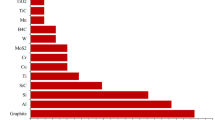Abstract
Permanent mould dies are used for various plastic injection moulding products. Most of the mould cavity is blind and henceforth difficult to finish. In this study, a novel magnetorheological fluid-based finishing process using permanent magnet tools has been developed for nano-finishing of cylindrical blind hole surfaces. Tools to finish the internal and flat-bottomed surfaces of the cylindrical blind hole are developed. The finishing performance of both tools is evaluated for finishing ferromagnetic material used in dies. The material of the die is P20 tool steel having 41 HRC hardness. Response surface methodology using a central composite design technique has been utilized for the plan of experiments and analysis of significant process parameters on the percentage change in surface roughness using newly developed tools. During finishing the internal cylindrical blind hole surface, the process parameters like rotational speed, reciprocation speed and abrasive mesh size are found to be significant. However, during flat-bottomed surface finishing of cylindrical blind hole workpiece, rotational speed, abrasive mesh size and abrasives volume percentage are found to process significant parameters. Experimentation at optimized parameters results in the final surface finish of 83 nm on internal cylindrical surface and 93 nm on the flat-bottomed surface of cylindrical blind hole workpiece.

















Similar content being viewed by others
References
Fallböhmer P, Rodríguez CA, Özel T, Altan T (2000) High-speed machining of cast iron and alloy steels for die and mold manufacturing. J Mater Process Technol 98:104–115. https://doi.org/10.1016/S0924-0136(99)00311-8
Hara K, Isobe H, Yoshihara H et al (2007) Ultrasonically assisted machining for mirror finishing of die (2nd report). J Jpn Soc Precis Eng 73:460–464. https://doi.org/10.2493/jjspe.73.460
Sk S, Hiremath SS (2016) A review on abrasive flow machining (AFM). Proc Technol 25:1297–1304. https://doi.org/10.1016/j.protcy.2016.08.224
Sankar MR, Jain VK, Ramkumar J (2009) Experimental investigations into rotating workpiece abrasive flow finishing. Wear 267:43–51. https://doi.org/10.1016/j.wear.2008.11.007
Jain VK (2009) Magnetic field assisted abrasive based micro-/nano-finishing. J Mater Process Technol 209:6022–6038. https://doi.org/10.1016/j.jmatprotec.2009.08.015
Umehara N, Kirtane T, Gerlick R et al (2006) A new apparatus for finishing large size/large batch silicon nitride (Si3N4) balls for hybrid bearing applications by magnetic float polishing (MFP). Int J Mach Tools Manuf 46:151–169. https://doi.org/10.1016/j.ijmachtools.2005.04.015
Kordonski W, Jacobs S (1996) Model of magnetorheological finishing. J Intell Mater Syst Struct 7:131–137. https://doi.org/10.1177/1045389X9600700202
Yamaguchi H, Shinmura T (2004) Internal finishing process for alumina ceramic components by a magnetic field assisted finishing process. Precis Eng 28:135–142. https://doi.org/10.1016/j.precisioneng.2003.07.001
Saraswathamma K, Jha S, Rao PV (2015) Rheological characterization of MR polishing fluid used for silicon polishing in BEMRF process. Mater Manuf Process 30:661–668. https://doi.org/10.1080/10426914.2014.994767
Phule PP (2001) Magnetorheological (MR) fluids: principles and applications. Smart Mater Bull 2001(2):7–10. https://doi.org/10.1016/S1471-3918(01)80040-X
Sadiq A, Shunmugam MS (2009) Investigation into magnetorheological abrasive honing (MRAH). Int J Mach Tools Manuf 49:554–560. https://doi.org/10.1016/j.ijmachtools.2009.02.009
Jha S, Jain VKÃ (2004) Design and development of the magnetorheological abrasive flow finishing (MRAFF) process. J Mach Tools Manuf 44:1019–1029. https://doi.org/10.1016/j.ijmachtools.2004.03.007
Das M, Jain VK, Ghoshdastidar PS (2010) Nano-finishing of stainless-steel tubes using rotational magnetorheological abrasive flow finishing process. Mach Sci Technol 14:365–389. https://doi.org/10.1080/10910344.2010.511865
Hung CL, Ku WL, Yang LD (2010) Prediction system of magnetic abrasive finishing (MAF) on the internal surface of a cylindrical tube. Mater Manuf Process 25:1404–1412. https://doi.org/10.1080/10426914.2010.499578
Singh DK, Jain VK, Raghuram V (2004) Parametric study of magnetic abrasive finishing process. J Mater Process Technol 149:22–29. https://doi.org/10.1016/j.jmatprotec.2003.10.030
Kang J, Yamaguchi H (2012) Internal finishing of capillary tubes by magnetic abrasive finishing using a multiple pole-tip system. Precis Eng 36:510–516. https://doi.org/10.1016/j.precisioneng.2012.01.006
Verma GC, Kala P, Pandey PM (2017) Experimental investigations into internal magnetic abrasive finishing of pipes. Int J Adv Manuf Technol 88:1657–1668. https://doi.org/10.1007/s00170-016-8881-0
Bedi TS, Singh AK (2017) A new magnetorheological finishing process for ferromagnetic cylindrical honed surfaces. Mater Manuf Process. https://doi.org/10.1080/10426914.2016.1269925
Grover V, Singh AK (2017) A novel magnetorheological honing process for nano-finishing of variable cylindrical internal surfaces. Mater Manuf Process 6914:1–11. https://doi.org/10.1080/10426914.2017.1339322
Paswan SK, Singh AK (2019) Theoretical and experimental investigations on nano-finishing of internal cylindrical surfaces with a newly developed rotational magnetorheological honing (R-MRH) process. Proc IMechE Part C J Mech Eng Sci. https://doi.org/10.1177/0954406219875773
Sirwal SA, Singh AK (2018) Analysis of the surface roughness for novel magnetorheological finishing of a typical blind hole workpiece. Proc Inst Mech Eng Part C J Mech Eng Sci. https://doi.org/10.1177/0954406218776036
Paswan SK, Bedi TS, Singh AK (2017) Modeling and simulation of surface roughness in magnetorheological fluid based honing process. Wear 376–377:1207–1221. https://doi.org/10.1016/j.wear.2016.11.025
Paswan SK, Singh AK (2019) Analysis of surface finishing mechanism in a newly developed rotational magnetorheological honing process for its productivity improvement. Wear 426–427:68–82. https://doi.org/10.1016/j.wear.2019.01.001
Mangal SK, Sharma V (2017) Multi-parameter optimization of magnetorheological fluid with high on-state yield stress and viscosity. J Braz Soc Mech Sci Eng 39:4191–4206. https://doi.org/10.1007/s40430-017-0889-3
Mangal SK, Kataria M (2018) Characterization of magnetorheological finishing fluid for continuous flow finishing process. J Appl Fluid Mech 11:1751–1763. https://doi.org/10.29252/jafm.11.06
Jain VK (2007) Advanced machining processes, 6th edn. Allied Publisherser PVT, Limited
Acknowledgements
The authors thank the Science and Engineering Research Board (Department of Science and Technology), New Delhi, for their financial support.
Author information
Authors and Affiliations
Corresponding author
Additional information
Technical Editor: Izabel Fernanda Machado, Dr.
Publisher's Note
Springer Nature remains neutral with regard to jurisdictional claims in published maps and institutional affiliations.
Rights and permissions
About this article
Cite this article
Sirwal, S.A., Singh, A.K. & Paswan, S.K. Experimental analysis of magnetorheological finishing of blind hole surfaces using permanent magnet designed tools. J Braz. Soc. Mech. Sci. Eng. 42, 140 (2020). https://doi.org/10.1007/s40430-020-2225-6
Received:
Accepted:
Published:
DOI: https://doi.org/10.1007/s40430-020-2225-6




